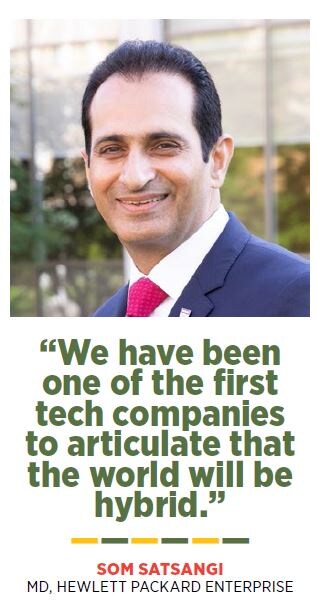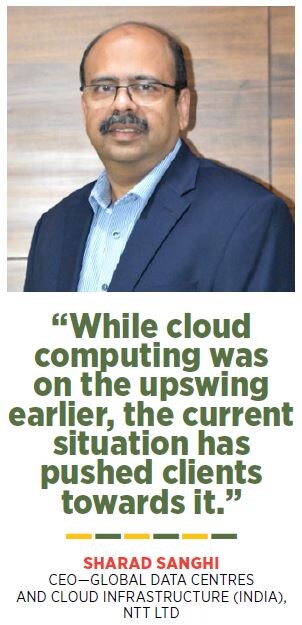The Covid-19 opportunity for big tech
From supporting work-from-home now to strategising for their customers' long-term shift to cloud-based models, large technology companies see many growth areas amid the pandemic


 Image: Getty Images / iStockphotoWhen the national lockdown was announced in the wake of the Covid-19 pandemic, some of the world’s largest technology companies sniffed a huge opportunity in helping customers tide over the crisis. As most offices sent their staff to work remotely, from the safety of their homes, it entailed a move to cloud-based systems.
Image: Getty Images / iStockphotoWhen the national lockdown was announced in the wake of the Covid-19 pandemic, some of the world’s largest technology companies sniffed a huge opportunity in helping customers tide over the crisis. As most offices sent their staff to work remotely, from the safety of their homes, it entailed a move to cloud-based systems.
While the initial rush was to establish the communications systems and the remote working capability needed for hundreds of thousands of workers, there will be a more permanent need in future to accelerate the shift towards the cloud, say some of the top tech executives in India.
Since the outbreak, networking tech provider Cisco has been working closely with its customers, partners and the industry, says Daisy Chittilapilly, managing director, digital transformation office, Cisco, India & Saarc. The aim has been to equip companies with tools and technologies that not only facilitate work from home in a secure manner but also help in quick and easy scaling up of work. “As a result, we have seen a massive surge in the demand and adoption of our cloud-delivered solutions,” Chittilapilly says. This has been across collaboration (via a software platform called Webex), security, communication management, and analytics. In March, Cisco registered over 14.3 billion minutes of Webex usage globally. In only one week in March, its security trial requests increased by about 40 percent of last year’s total requests. “These numbers indicate the rise of a new way of working, which I believe will become a norm in the future,” she adds.
While in the short term, communications and remote working have taken centre stage, much more is in the offing. “Digital transformation takes on a new meaning during this global crisis. It will be the new foundation for the future, and leveraging the cloud to future proof their organisations and ensure business resilience is more important than ever for customers,” says Karan Bajwa, managing director, Google Cloud, India.
Google Cloud offers three important capabilities for digital transformation: First, high-scale, highly secured and reliable infrastructure, including cutting-edge computing, storage and networking through many data centres—called ‘regions’—around the world. Second, a digital transformation platform to manage data at scale, develop and modernise applications, understand and analyse data, collaborate with people and take advantage of new artificial intelligence capabilities. Third, a suite of industry-specific solutions that deliver new digital capabilities in health care, retail, media and entertainment, and other industries.Google is helping thousands of organisations change themselves. Worldwide, if one looks at the 10 largest companies in different industry verticals, nine media companies, seven retailers, six energy and utility companies, five of the top 10 banks, telecommunications companies, manufacturers, and software companies are using Google Cloud as part of their business transformation.
As people transition to remote work, many are looking to build skills and increase knowledge. To help, Google is offering its portfolio of Google Cloud learning resources, including an extensive catalogue of training courses. Anyone can gain cloud experience through hands-on labs, and learn how to prototype an app, build prediction models and so on.
Teams can also build their skills through Google’s on-demand courses on Pluralsight and Coursera. “Our most popular learning paths, including cloud architecture and data engineering, are now available to all,” Bajwa says.
Still, companies will continue to use a ‘hybrid’ model of both privately-owned and publicly-sourced data centres. “We have been one of the first tech companies to articulate that the world will be hybrid—we have consistently maintained this outlook for the last five or more years,” says Som Satsangi, MD, Hewlett Packard Enterprise (HPE) in India.
HPE customers are reviewing their IT architecture and blueprints to determine the best options—a combination of public cloud, private cloud, and edge environments (meaning the points of networks farthest from the data centres, touching individual users) for their data and applications. The best solution will be determined by workloads and their characterisation of performance, security policies, compliance, data localisation, audit requirements, and cost.
IT decision-makers are seeking stability and service availability as a priority. However, at the same time, some organisations are facing severe decreases and others severe increases in demand for their products and services. From an IT perspective, this means there can be extreme changes in capacity demand, and there is the requirement to support new workloads and services, notably remote applications and virtual interfaces.
In the short term, this drives changes both in terms of technology and flexible IT delivery and financing models. “But these short-term changes are just amplifications of longer-term trends which are fundamentally shifting organisations’ approach to sourcing and running IT,” says Satsangi.
HPE’s Pointnext services portfolio has comprehensive expertise to help customers assess their IT blueprints and build an architecture best suited for their workload. HPE’s advisory service Right Mix Advisor, through an immersive dialogue with the IT decision makers, guides them towards the best mix of tools customised towards their individual complexities and workflows. The company has highly specialised experts in the Pointnext team to help customers optimise their use of both Amazon Web Services and Microsoft’s Azure—two of the largest cloud providers.
Satsangi says customers are becoming successful in optimising their IT landscapes, reducing complexity and cost while freeing up resources to focus on innovation and other business critical requirements. Hence, the cloud providers see a surge in the use of their solutions. At Microsoft, the company has seen a 775 percent increase in the number of monthly users for Teams, its collaborative software platform, in one month in Italy.
“We have seen a significant spike in Teams usage, and now have more than 44 million daily users,” the company said. Those users generated over 900 million meeting and calling minutes daily in a single week towards the end of March. Windows Virtual Desktop usage has grown more than 3x. And the government’s use of public Power BI, a data visualisation platform, to share Covid-19 dashboards with citizens has surged by 42 percent in the week.Microsoft is implementing a few temporary restrictions designed to balance the performance for all its customers. It has placed limits on free offers as well as a few resources for new subscriptions to prioritise capacity for existing customers. These are ‘soft’ quota limits, and customers can raise support requests to increase them. If requests cannot be met immediately, the cloud vendor recommends that customers use alternative data centres—called ‘regions’ and the company has 54 of them live currently—that may have less demand surge. “To manage surges in demand, we will expedite the creation of new capacity in the appropriate region,” Microsoft said.
“While cloud computing was already on the upswing earlier, the current situation has further pushed clients towards it,” says Sharad Sanghi, CEO—global data centres and cloud infrastructure (India) at NTT Ltd. “The government has made data localisation mandatory and we had anticipated it to be a year of accelerated growth in the hybrid cloud market.” NTT was prepared for growth, he says. To meet the increased demand, NTT is providing clients with simplified end-to-end cloud management services across multiple platforms. It expects more companies to move to the cloud to take advantage of the operational and cost gains and improved profitability. “We also hope more on-premises customers, who faced challenges during the lockdown, will transition to the cloud,” says Sanghi. Further, due to cash flow and logistical challenges, customers will prefer the cloud rather than incurring capital expenditure on buying and shipping IT hardware and software assets, adds Sanghi.
NTT is offering customers multiple cloud options via both its own public cloud—called SimpliCloud—and through partnerships with global cloud providers. Its approach is to help customers choose the most suitable platform for their workload and plan the migration.
In the move to the cloud, security is an important factor, says Sajan Paul, managing director and country manager, India and Saarc, at Juniper Networks. “Earlier, it was more of an operational expenditure discussion with our customers. However, now, it has become an important discussion as part of their business itself,” he says. Therefore, Juniper has solutions, Contrail, which allow customers to expand their IT assets across multiple clouds in a multi-cloud security scenario. With Juniper’s Mist and SRX series of products, it can provide enterprise-grade work-from-home infrastructure, he says.
Juniper is working with customers to tackle massive distributed denial-of-service (DDoS) attacks, which slow down the networks significantly. Its new solution in collaboration with Corero Network Security offers service providers with an intelligent DDoS protection that self-heals the network.
Mid-sized Indian IT services companies are also seeing opportunity. “We are seeing our services across infrastructure services and cloud, remote service desk, break-fix services (services as/when needed) and information security, all being in demand due to the nature of the event and the sudden need to shift to work-from-home,” says Anand Ramakrishnan, CEO of Qtek Systems.
In addition, robotics process automation—the use of software bots to automate manual processes—is also getting more attention, he says. So far, this was restricted to certain areas of banking and finance and customer support centres, but Qtek has recently seen a rise in interest for this service. This is possibly because customers have begun to realise that automation spend today may result in substantial benefits during times of crises.
“Once Covid-19 comes to an end, we expect to see a lot more action around cloud and information security together as a strategy,” Ramakrishnan says.
First Published: Apr 30, 2020, 14:05
Subscribe Now
